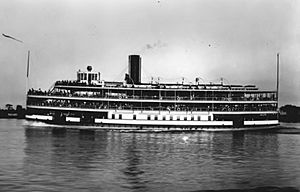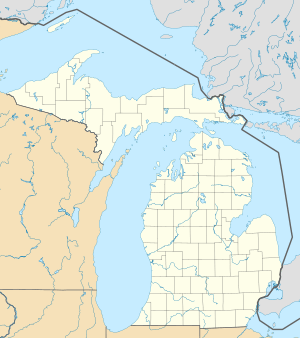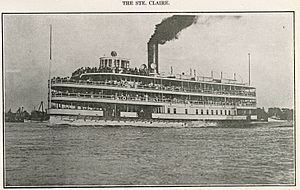Ste. Claire (passenger steamboat) facts for kids
The SS Ste. Claire is a historic steamer found in Detroit, Michigan. This amazing ship was built in 1910. It was one of the last big propeller-driven ships used for fun trips on the Great Lakes. In 1992, the Ste. Claire was named a US National Historic Landmark. Sadly, a big fire in 2018 badly damaged its upper parts. Now, only its strong steel frame remains.
 |
|
| History | |
|---|---|
| Name | Ste. Claire |
| Operator | Detroit & Windsor Ferry Company |
| Builder | Toledo Shipbuilding Company |
| Yard number | Hull 116 |
| Launched | 7 May 1910 |
| Fate | Damaged by fire on 6 July 2018, awaiting restoration |
| Status | Awaiting restoration |
| General characteristics | |
| Tonnage | 870 (gross), 507 (net) |
| Length | 190 ft (58 m) |
| Beam | 50 ft (15 m) |
| Draft | 14.5 ft (4.4 m) |
| Depth | 17.3 ft (5.3 m) |
| Installed power | Triple expansion reciprocating steam engine |
|
Ste. Claire (steamer)
|
|
| Location | Riverside Marina, 11000 Freud St., Detroit |
| Built | 1910 |
| Architect | Frank E. Kirby, Toledo Shipbuilding Co. |
| NRHP reference No. | 79001177 |
| Significant dates | |
| Added to NRHP | November 2, 1979 |
| Designated NHL | July 6, 1992 |
Contents
History of the Ste. Claire
The Ste. Claire was built for a company that ran ferries. This company started in 1881. They offered boat rides between Detroit, Windsor, Ontario, and Belle Isle Park.
Trips to Bob-Lo Island
In 1898, the company started leasing Bois Blanc Island. This island later became known as "Bob-Lo." It was a popular place for day trips. People enjoyed picnics, a small amusement area, and dancing there.
The trips to Bob-Lo Island became very popular. So, in 1902, the company asked Frank E. Kirby to design a new passenger ship. This ship was named the Columbia. But even with the Columbia, more people wanted to visit the island.
So, the company ordered another ship. Frank E. Kirby designed this one too. It was a bit smaller than the Columbia. This new ship was built at the Toledo Shipbuilding Company.
Launch and Service
The Ste. Claire was launched in 1910. It started carrying passengers between Detroit and Bob-Lo Island that same year.
Later, new bridges and tunnels were built. These connected Detroit and Windsor, and Detroit to Belle Isle. This meant fewer people needed the ferry service. By the late 1930s, the company mainly ran trips to Bob-Lo Island.
The Bob-Lo Island trips and the Boblo Island Amusement Park were sold in the 1940s. They were sold again in 1979. But the Ste. Claire kept going! It operated between Detroit and Bob-Lo Island until 1991. That's 81 years of service!
After Bob-Lo Island
After the amusement park closed, the Ste. Claire was sold. It was then taken to Toledo, Ohio, in 2003 for repairs. In 2015, the ship was moved to the Rouge River in Detroit. Its restoration was still being planned.
The Ste. Claire was even used in a movie! It was temporarily changed for the 2014 film Transformers: Age of Extinction.
Fire and Future
On July 6, 2018, the Ste. Claire caught fire. It was docked on the Detroit River. The fire was accidental and could not be stopped. It destroyed the beautiful wooden parts and upper decks.
But the ship's co-owner, Ron Kattoo, said, "She's 110 years old, but she's well-built and she survived." He added that the ship was already a steel frame, ready to be rebuilt. As of 2019, the Ste. Claire is docked at Riverside Marina in Detroit.
What the Ste. Claire Looks Like
The Ste. Claire is a propeller-driven ship. It has a strong steel body and a wooden top part. The hull, or bottom part, is 190 feet long. It is 50 feet wide and 17.3 feet deep.
The ship gets its power from a special steam engine. This engine uses large boilers to create steam. The main deck hangs over the hull. The open decks above are rounded at the front. This was a common design for the Bob-Lo ships.
Inside the Ship
The main staircase is in the middle of the main deck. It leads up to the higher decks. Another staircase goes down to the crew's areas. On both sides of the main stair, there were openings to load passengers.
In front of the stair was a large open space. Behind the stair, a walkway went across the ship. You could also see the main engine room from a well here. Food counters were at the back of the main deck. There were also stairs leading to the upper decks. Restrooms and crew quarters were on the sides of the ship.
The main staircase led to the main cabin on the second deck. This cabin had fancy mahogany wood and a cream-colored ceiling. Behind the cabin was a dance floor. The main cabin had doors leading to open spaces at the front and back.
Another stair led to a smaller cabin on the third deck. Doors here opened to the outside deck and a "beer garden" area. A final stair on the open deck went to the very top deck. This top deck had the pilot house, where the ship was steered. It also held the lifeboats. Public access to this top deck was limited.



